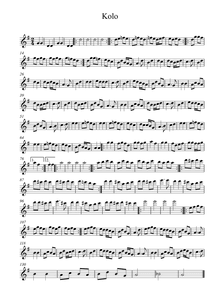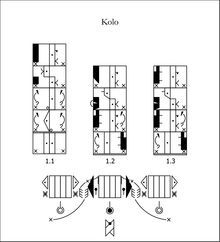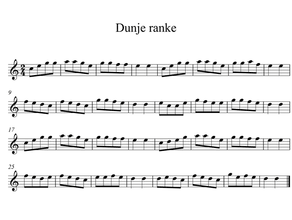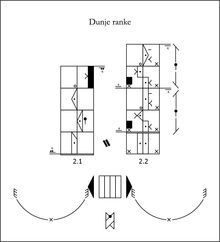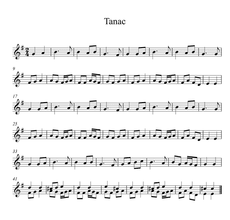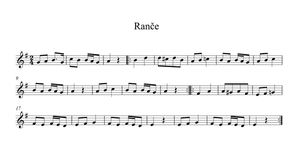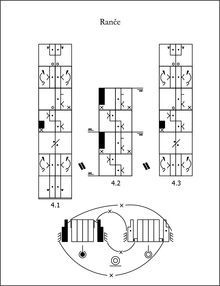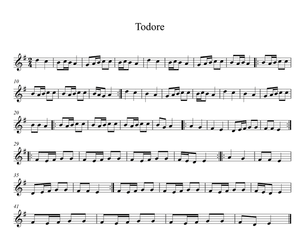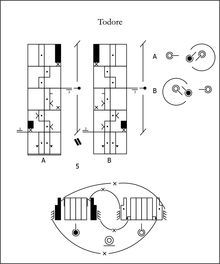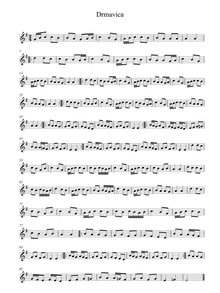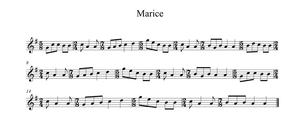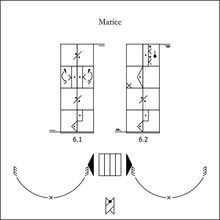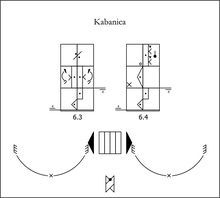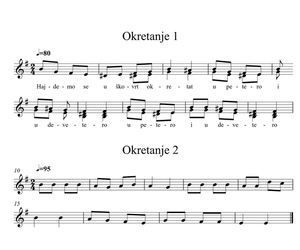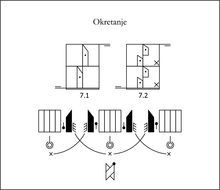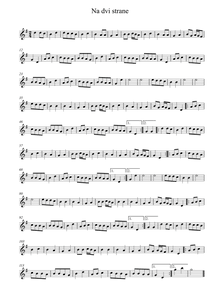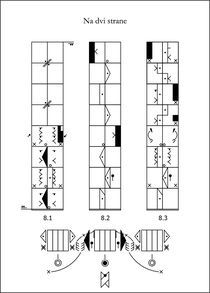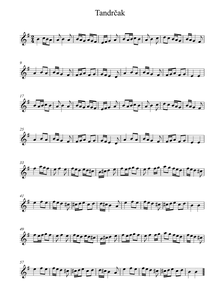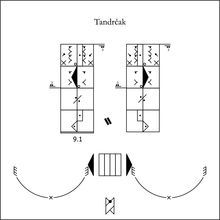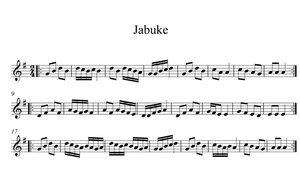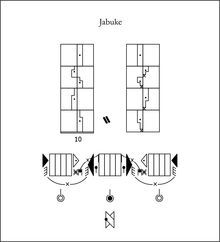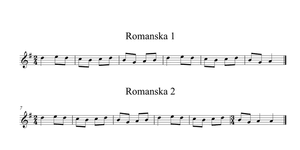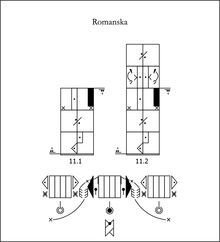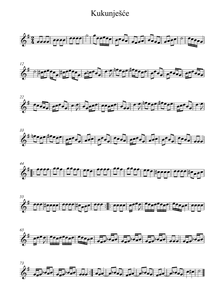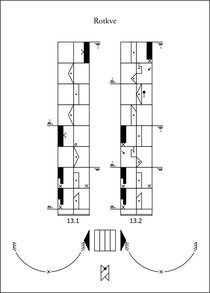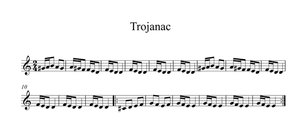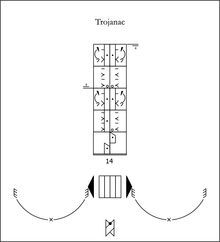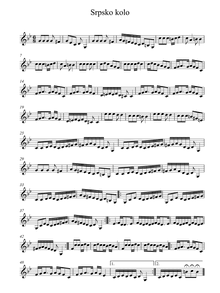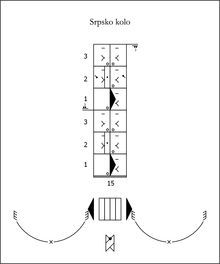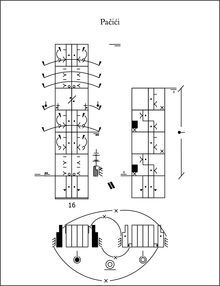KOLO
It is also known as Veliko kolo, or Kolo na jednu stranu, but the Sokac call it Kupusarsko kolo. It is always the first and closing piece at a dance. The words Ajd’ zaigrajmo! invite people to dance Kolo. It is danced both by men and women in a closed circle. In the old times, the order of one man one woman was strictly followed, women putting their hands on the shoulder of men (holding a woven handkerchief, maramica, in their right hand, which they sometimes waved during the dance while yelling), the men, standing in front of or behind the women, holding each other’s hands, or sliding their hands into the cloth, serving as a belt, on the women’s waist. Lately, several men (shoulder hold) or women (holding hands or crossing them behind the back) may stand beside each other, everyone with slightly raised hands or arm-in-arm.
Kolo always starts to the left and slowly moves left. For bagpipe music, the bagpiper occasionally used a short improvisational part (tiny bounces while the piper filled his bag with air and tried some tunes). The tamburica band begins with eight direct beats (signaling the tempo of the dance), then the dance started with simple stepping motifs. Women can enrich their dance with a motif well-known all over Baranya and Bačka. Men do a more difficult variation of this motif, but also perform lots of heel klicks, stamping and cross steps in the free part of Kolo, which starts after a change in the musical tune (new tune). After this, the stepping motif may return for the sake of rest, then the improvisation again, but with increasing speed. This is signposted by a yell for the piper from Kökény:
Oj gajdašu, živina ti prste, Hey, piper, damn your fingers
Zar ne vidiš, kako noge krste! Can’t you see, our feet are getting tangled!
Marcika, Kloćo, Pöttyös used to be pipers in Kökény.
There is a rule concerning the enrichment of Kolo as well as all Bosnian dances: both feet must not be in the air at the same time. It should be danced with small steps, on the whole sole, with sharp, but not jumping trembles. The men pinned colorful pearls (dronke) onto their hats, the girls wore necklaces made of silver coins (cvancike, križaki), so these gave a rattling sound during the dance. The most important feature of the Bosnian dance is the tremble (drma) paired with a pleasant posture.
The songs in the Kolo most probably developed from the yells, which, initially, could be started at any time but later were placed on a specific tune part (e.g., Alaj volim u kolu igrati). The improvised songs and yells were of considerable importance in the life of the village. Pieces of news, village events, gossip were made public in this way, so there were always lots of bystanders around, who were interested not only in the show but mostly in the transmitted information. The lyrics narrated about married life, love, lovers, the parish priest, officeholders, musicians, or dancers, often in a joking or criticizing manner.
Each band has its own Kolo music, which consists of similar tunes or the same tunes linked together in a varied way. This characterizes the whole of the southern areas, called Southern Region (territories named as D musical dialect by Vujicsics Tihamér). The most frequently used tonalities are E and A, as these are the basic sounds of the bagpipe and the tamburica band.
This was the oldest and most popular dance with some famous dancers such as Udvarácz Márkó from Áta, who threw his hat into the air while dancing, and it miraculously landed right on his head after one or two beats. Wearing the hat on one side a bit signaled a party man, who loved dancing, bećar, (also the favorite of women).
MUSIC
DUNJE RANKE
Dunje ranke is the favorite dance of the elderly. It consists of a Kolo for men and women (the first part) and a couple dance (second part). In the first part, the dancers step to the left and right in a closed circle while joining with the Kolo hold. For the second part of the tune, the men make a half turn with the woman on their right to the right and a half to the left, returning to the beginning position of the closed circle. They use the Tanac hold when turning (the woman’s hands are on the shoulder of the man; the man’s hands are on the woman’s waist).
Today there is a circle dance with a similar melody and of the same name performed in Serbia and the northern parts of Croatia (Dunje ranke, Duneranka). The Serbs in Hungary know it as a circle dance, too. However, the Bosnian Dunje ranke is slower, sometimes accompanied by polyphonic singing, a dance half-way between the Kolo and Tanac for the music of a piper. The persons who described it from Áta, Pogány, Szalánta, all categorized it as a very old dance, of their grandparents’ time (referring to the 1880s). Therefore, it cannot be grouped as a newly ‘taken-over’ one (unlike the other Serb origin ones, which spread among the Hungarian Serbs and Croats after the occupation of Southern Region by the Serbs from the beginning of the 1920s.) The dance structure itself is a rarity (the first part: closed circle, the second part: partner dance). A Serbian dance called Srpkinja has a similar structure, but it is for well-known musicians’ music and choreography (I. Bajić and N. Vulko Varadanin) from 1902. (Bartók Béla recorded the music of Srpkinja as folk-dance music by phonograph in Temesmonostor in 1902, though its author was a fellow student of his at the Music Academy in Budapest…)
If we search for similarities, we find the wedding dances of the Croats by the river Dráva. There the prescribed Kolo form is broken by the two Kolo leaders taking the bride (or another woman) from the line into the middle of the circle dancing a partner dance with her there. Dunje ranke danced by the Bosnians represents the transformation period from Kolo to the partner dance; we suppose there was a similar process in the case of Tanac as well.
MUSIC
VIDEO
TANAC
The most favored partner dance is sometimes called Po dvoje. Generally, it is danced by a man-woman couple, but if there is no man available, then by two women. The woman puts her hand on the shoulder of the man (Csárdás hold), while the man is holding the woman’s waist. There is no set formation, though according to one source from the 40s, men and women started it lining up opposite each other. However, at the end of the 19th century, it was known as a circle dance.
It has only one basic motif, which consists of two parts: the first is danced bouncing-trembling in place, the second one is a right turn with trembling steps. The first part is face-to-face, but in the second part, the dancers might shift towards each other’s side a little. In one variation, the woman may slightly be turned by her waist in the first part. And for the whole tune of the second part, a full circle might be done; we have examples of halving this (changing direction is done without a change step). It is allowed for the couples to move in the space a bit. It can be decorated with stamping, foot-swinging.
If we study the tune, it cannot be decided if a Kolo melody became independent or a Tanac one integrated into Kolo music. It must be stated that the main theme of Tanac (Išla snaša...) and one of the tunes of Kolo are nearly the same. By the name Tanac, there are several well-known tunes, which shows its popularity (Da sam ptica..., Dođi diko i nemoj..., Da mi nije ljubavi...); the similarity of the latter one to Dunje ranke is striking. Bosnyák Mária (Pupina) from Szemely used to play all of them on her harmonica, on which she performed regularly at the Sunday dances in Pogány.
The most probable supposition is that Tanac as a partner dance might have evolved from Kolo, due to the influence of other fashionable partner dances, such as Csárdás, around the middle of the 1800s. Similar dances can be found with neighboring minorities (Sokac: the tune Snašo, U tanac; Serbs of Baranya and Tolna: Mađarac, Sečujac; Serbs of Bačka: Cigančica, Po dvoje; Northern parts of Croatia: Čardas, Drmeš; Serbs from Desk: Po dvoje; Serbs around Budapest Lepa Nera). It must be noted, that different partner and circle dances exist by the same name by the Adriatic Sea (Krčki tanac, Paški tanac), in the Dinari zone (Lički tanac), and of Crna Gora origin in Serbia (Sitan tanac, Pleti tanac). This implies that the name Tanac is ancient and denotes a partner dance.
The dance’s relationship to magic is indicated by starting it with the yell Za kudilju!, so that the hemp should grow higher, as the explanation goes. Consequently, Tanac may also belong to the family of dances classified as dances performed for the sake of a better harvest (like Dučec from Posavina, Nebesko from Slavonia), which are also found in the medieval “branle” tradition (see the French “Hault Barrois” branle).
The intensified music and steps of Tanac, as well as the partner dances, always create a heightened atmosphere at a dance; we heard of an instance from the 50s from Szemely, when a lad danced it alone on a chair for a bet.
At weddings, solely Tanac was danced during the gift-giving (fiancée dance).
MUSIC
VIDEO
RANČE
Ranče, which is also a popular partner dance, is played by the band after Tanac, these days without any intervals between the two. When Ranče is finished, Tanac follows, then Pačići (the latter became popular from the 30s). All three dances have the same hold and the two-part structure. The length of the two parts of Ranče may differ; bands would take this opportunity to make the dance more varied. Dancers needed to adjust skillfully to the changes of the musicians, which created a buoyant mood.
The first and third part of Ranče ends with a knee-bend, with the second part being free, concerning the steps and the move in the space. At the end of the first part the knee-bend may be done twice, depending on the music; but both feet must stay on the ground as a rule (differently from what is spread by dance ensembles in the past 20 years, where, while jumping on one leg, the other heel is raised high). Ranče is a favorite among the Sokac in Baranya county; it is also known with songs, similar to that of Bosnians. Its tune resembles the tune of Kolo. Stopping the tune and the music (pause both in the music and the dance) is analogous in Slavonia (Nebesko), in Bačka (Ćućkavo kolo, Ja sam Jovicu), in Srem (Zurka) and south-western Serbia (Starinski zaplet).
Men used to play a joke with their partner and stood on their tiptoes, suddenly standing erect, when they should have done the knee-bend together with the woman.
MUSIC
VIDEO
TODORE
It is also called: Po jedan put drmavica or Tedu, tededu taken from one of the songs’ beginning line. Todore was a favorite dance of the carnival season but was also danced at weddings or pig slaughter. One man danced with two women on his sides. Older, good dancers often chose younger, clever girls as their partners. It has the same hold as Tanac, and the steps are equal with the second part of Tanac’s. Adjusting to the tune, the man dances first with one of the women (for the time of a quarter tune), then with the other woman, for the same length of time, but in the other direction. The waiting-woman dances the basic step but may spin as well. This basic form may change (the man turns more with one woman), lending itself to plenty of funny, playful possibilities. The skillful men “stole” another man’s “waiting” woman more than once; so, one man sometimes danced Todore with 5-6 women.
The melody is an old piper one, often with lines of differing lengths. The songs’ lyrics are funny, witticising, often dirty.
Todore is also popular among the Sokac in Baranya county. Similarities are found among the Sokac, Serbs, and Bunjevac in Bačka (Keleruj); in Slavonia (Todore, Mista); and in Srem (Todore).
The three-person dances are unique among the Hungarian Croats’, Serbs’, and our southern neighbors’ dance culture; there are only rare excepts outside the Hungarian zone. Their origin may be searched in the late medieval dance culture (which, together with other impacts, might have been passed on to different minorities by the Austrian-Hungarian Monarchy), or in the culture of the Germans living in the same area.
MUSIC
VIDEO
DRMAVICA
Folk memory recognizes several, sometimes similar dances under the term Drmavica. The name refers to an essential feature of the Bosnian dances, the tremble (drma).
Todore is mentioned by the name Po jedan put drmavica, as there is a repeated tremble in the dance. Na dvi strane kolo, as well as Kabanica, is meant by Po dva put drmavica (the number 2 in the former one denotes the number of trembling steps taken to the left, while in the latter it means the two jolts, i.e the knee-bend, at the end of the step pattern). Po tri put drmavica is another name for Marice kolo, while Po pet put drmavica for Kabanica (numbers 3 and 5 refer to the number of steps). Kratka drmavica or Dugačka drmavica names are also used for Marice, Kabanica, and Trojanac. The way of counting among folk people sometimes produces something peculiar; Kabanica is also known as Po sedamput drmavica, because, although it consists of 12 beats, the counting goes to 7 je-dan-dva-tri-čet-ri-pet-šest (these are quaver notes), and -se-dam (quarter notes).
We must differentiate two types of Drmavica as for the dance steps, structure, and the melodies: the Marice kolo and the Kabanica. Both are danced in a closed circle, by men and women alike, with Kolo hold, stepping either only to the left or symmetrically, to the left then right. Long verses of songs are attached to both; the names Marice and Kabanica themselves refer to the lyric (Oj, curice, Marice...; or Kabanica od seksera haj, haj...).
The motifs of Marice kolo (Po tri put drmavica) are characterized by the small traveling steps danced on the whole foot, together with the intensive, but small and strong trembles, touching the ground. Kabanica (Dugačka drmavica) is also featured by this style, though it contains longer motifs. Marice kolo is considered a Bosnian dance (kupusarsko) by the village Sokac. They are the closest to the Bosnians (as for their settlements, folk costume, dances, songs, and traditions), while they view Kabanica as their own. It is mentioned as a Pécsudvard dance (udvarski ples) together with Na dvi strane kolo by people from other villages.
Here we should mention some words about Pécsudvard. Stipan Pavković Patak, the outstanding musician, the virtuoso fiddler of the Bosnians, lived in the village in the 1950s and early 60s. He and his band were well-known in Baranya county. The Bosnian communities considered his exceptional music as their own. During his work, Pécsudvard became the leader and style-setter in music and dance culture among the neighboring Bosnian villages. He was a good dancer, too. As he played in many-a-places (e.g., in Bačka), the Bosnians got to know several dances through him.
Musical parallels of Marice kolo are easily found in Slavonia (Dorata) and along the river Drava. The dance Ime moje in Central Bosnia has a similar tune, which is interesting, as it seems to have been linked to the motherland.
Sitne bole is a Kabanica style dance of the Drava river Sokac. Its melody is part of Patak Drmavica’s tune. The girls in Pogány sang as follows: Mužikaj nam sitne bole racke, da igraju curice poganske! The relationship between the two dances (Sitne bole, Kabanica) are inevitable (common origin, or descending from one another).
MUSIC
VIDEO
OKRETANJE
Girls used to dance before the dancing began or in the intervals. It reminds us of the Hungarian ‘karikazo’ dance. They either simply hold their hands or cross their hands in front. It is begun by a song, in a closed circle by stepping; then, a faster-paced twirl follows accompanied by faster singing. These two parts may then be repeated. The numerous verses usually have the same beginning line (Hajdemo se u škovrt okretat; Hajd’te druge da se okrećemo); the lyric may correspond to the lyric of Marice kolo, Na dvi strane or Bećarac. They tend to be of funny, mocking, or love-related topics. Among the Bosnian dances, this dance is the only one that is performed solely by girls, merely for singing. Several melodies are known, some being a new style Hungarian folk song with Croatian lyric. Its most commonly used form is one from the oldest pieces for its music and lyric.
MUSIC
VIDEO
NA DVI STRANE KOLO
It is also called Po dva put drmavica. There is a unique tune (most probably originating from Pécsudvard) that belongs to the Bosnian dance Na dvi strane kolo. Some occurrences from the past should be mentioned here, when the left-moving Kolo divided, and moved symmetrically in both directions when the Kolo leader signaled it with the words Na dvi strane idemo!. We find parallel examples of other ethnic groups for the symmetric Kolo, which signifies the kinship.
It is danced by men and women in a closed circle with Kolo hold. We differentiate two versions of it. One keeps strictly to being symmetrical in the right-left movement. The other moves more to the left than right and the steps are not direction-symmetric.
Quite a lot of lyrics are known for the Na dvi strane kolo. They are interchangeable with the lyrics of Marice kolo, Okretanje, and Bećarac. Similarly to Marice kolo, where the 10-syllable-lines are lengthened to 13-syllable-ones by inserting the word Marice, the Na dvi strane kolo expands the ten syllables by the word ‘Ej’ into an 11-syllable line, and the proportioning of deseterac is 4/6. Based on this fact, we can place neither Marice nor Na dvi strane among the oldest dances.
Na dvi strane kolo is called Šklecalica by the Sokac from Olasz, and Trusa by people from Mohács. They consider it an old dance and dance it quite similarly.
The basic structure of Kolos, namely, two-steps-to-right followed by two-steps-to-left (or two left then two right), is widespread among other Croatian and Serb ethnic groups as well.
MUSIC
VIDEO
TANDRČAK
Every village views it differently whether Tandrčak is an old or a new dance (from the 1930s). The hold, the formation in the space, and the steps suggest the latter, though.
It is danced by both men and women, mostly with lowered arms holding each other’s hand, in a closed or open circle. The motifs are begun to the left (which is typical of Bosnian dances) dancing them symmetrically to the left, then to the right. Their main features are the quick, small, traveling steps and the occasional virtuoso series of downbeat trembles built on knee-bends; sometimes, for the sake of the show, several steps are condensed into one musical part, though its length would not allow it.
Short (two-lined) songs are sung during the dance, analogically to the tune and lyric in Slavonia.
The virtuoso melody of Tandrčak by the local fiddler (Patak or Stipa) is known from Pécsudvard, where this dance was the most favored one. Its musical analogies are found in Slavonia and among the Bunjevac in Bačka, but among the later ones, it was transformed into a partner dance.
MUSIC
VIDEO
JABUKE
Jabuke was the favorite dance of young and old, perhaps due to its simplicity, probably to its three-person nature. Two women dance it with a man placing their hands on that shoulder of him where they stand. Their other hand holds his hand behind their backs. These three-person units formed either a closed or an open circle, lining up behind each other in the dance hall. Sometimes the best dancers led the line; on other occasions, this had no significance. The line, while stepping, moved more forward than backward, thus moving all around the room anticlockwise. It is a new fad that the units may turn around its nucleus, that is around the man.
The structure of the songs correlates to the lyrics of Marice kolo (e.g., the insertion of the word jabuke into the 10-syllable line).
Jabuke is thought to have appeared in the 1930s. It was brought to Pécsudvard from Hercegszántó by Patak.
Jabuke is known by the Baranya Sokac as well, calling it by the same name or Jabučice, Jagodice. A three-person form analogy is the dance of the Gara Bunjevac, Keleruj, or a music analogy from Slavonia, Žita, or the widely known song from the period between the wars with the beginning line Došlo pismo iz Bosne...
MUSIC
VIDEO
ROMANSKA
Romanska was well-known everywhere, but it is connected by most people to Pécsudvard (perhaps because of its good dancers). It was labeled as a complicated dance, so not many could do it; it is hard to reconstruct it from the fragments we have today.
Both men and women danced it, in an open circle, hands lowered and held. The best dancer stood at the left end of the circle. If there was a change in steps or direction, he dictated it.
Radics Márkó, the famous dancer from Pécsudvard, could perform it doing the trembles in the most beautiful way (sitno) and with lots of improvisations.
It was danced either symmetrically or only to the left. The tune of Romanska was one beat longer in Kökény, which needed one more knee-bend. That tune is slower; it resembles a piper’s play, whereas the Pécsudvard theme is much faster, probably because of the violin.
The following yelling-like line, sung for a tune, is also from Kökény:
Aj, sviraj racki, da igram Romanski! Play music in Serbian style, I dance Romanski!
Romanska shows kinship with Drmavica among the Bosnian dances.
MUSIC
VIDEO
KUKUNJEŠĆE
Kukunješće was already danced around 1925 in Pogány. Today it is one of the most well-known and popular dances in Baranya county; what is more, it is known by Hungarians in Bačka. Unlike the Bosnian dances, it starts with the right foot to the right. Men and women dance it with lowered, held hands in an open circle. It moves with running steps, but the original motifs have transformed into something of a tremble, or very close to the tremble, and there is a motif in which the left leg starts the right move. It may be decorated with contra stamping steps or cross-steps, which resemble the original Serb motifs.
The bands play it with many melodies in Baranya; one of them starts like a march (the Kukunješće tune of the Serbs around Budapest is not known in Baranya). These melodies do not have much in common with the ones in Serbia. There was no singing during the dancing, except for one yelling-like verse:
Alaj igram, alaj znam, I am dancing, I can do it
Kukunješće da igram, I am dancing the Kukunješće
Sitnu, malenu, Small ones
Ne uzimaj za ženu. Don’t marry me.
It is widely spread in today’s Serbia. It is called Kokonješte or Kukunješ, but its style is hugely different, being the closest to the well-known Moravac.
Kukunješće is an excellent example of the interaction between the people of the Carpathian Basin. The name stems from Romanian (meaning a young boy), it was transmitted by the Serbs to Baranya, where the gypsy musicians of Mohács played it to the Bosnians and Sokac (who are Croatians).
MUSIC
VIDEO
ROTKVE
The old call it Rotkve based on its lyrics (Rotkve, rotkve, rotkve, na tavanu rotkve...), but at some places, it is called Hopa-cupa. A dance called Zaplet in Serbia and along the river Maros equals the Baranya dance, as the hold, and space formation is the same as in Kukunješće. Among its motifs, we find ones close to the original (danced mainly by the old) and new ones. It starts to the right, also moving to the right, like all the dances taken from the Serbs. Many verses are sung for its simple melody. A lot of these are identical with the original Serb version (e.g., Hopa, cupa, skoči, da ti vidim oči...).
It is widely spread among the Hungarian Croats and Serbs, similar to Kukunješće and Vranjanka (Srpsko kolo).
MUSIC
VIDEO
TROJANAC
Trojanac, known in western Serbia, would not be recognized by those who meet it these days in Baranya. There a flutist used to play it; here, the melody played on the tamburica or harmonica got quicker, more ornamented and longer: today, the name Četvoranac would suit it (as Trojanac refers to the three repeated tunes and dance motifs). The rule of starting it to the right is not always applied, but the hold and the space formation are identical with the other Serb dances. The high-speed music is matched with a simply structured dance. Its essentials are the five “upbeat “ trembling steps. Two variations are known: symmetric and only to the left. Recently a new choreography came to life (with movements inward and outward, to the right and left and with raising the hands), but the old do not dance it. Good dancers are allowed to improvise instead of the trembles.
Its emergence is dated back to the 1930s. Baranya is the only place where it is danced in Hungary. Outside western Serbia, we can see it around the area of Šumadija, Pomoravlje, and Podrinje.
MUSIC
VIDEO
SRPSKO KOLO
The 7/8-beat-melody (Šano, dušo...) took a long way (figuratively as well) from Vranje, southern Serbia until it reached its recent, nicely developed 6/8-beat-version of the Mohács tamburica bands. The Serbs along the river Maros call the intermittent melody Žikino kolo or Vranjanka. Still, the Hungarian Croats and Serbs do the same type of symmetrical right-moving dance as it is performed in Baranya county for the music of Srpsko kolo. This dance does not resemble the original of Vranje, instead it is related to Serbian dances called Jovančica (Jovanke, Stojanke). Besides the lowered-hand hold, we sometimes notice a slightly raised and elbow-bent hold, which is the hold of town dances in Serbia (gradske igre). It was a favorite of all ages due to its simple step. It was also called Devojče, Radojče, according to the lyrics of its songs.
MUSIC
VIDEO
PAČIĆI
Most probably, it was in the 1930s when Pačići (threatening, pointing/displaying) spread. It is danced in two parts, by man-woman couples with Tanac hold, without set formation. The first part is a threatening one, with clapping, the second is identical with Tanac ‘s second part, which means that the couple turns along a whole or semi-circle (in the case of the latter one there is also a change in the direction).
Many parallels can be drawn to Pačići. Its western European origin is documented. It is danced in areas where the civic dance fashions (German or Polish) had an impact (often spread by the local German minority). So, it can be found in Slovenia, Bačka, among the northern Serbia Hungarians, the Székely in Bukovina (both in Hungary and at the Lower-Danube regions). The Baranya version resembles mostly the Mazuljka dance of the Bunjevac, but the couples move less in the space.
MUSIC
VIDEO



